2014 CHRYSLER 300 coolant level
[x] Cancel search: coolant levelPage 535 of 615
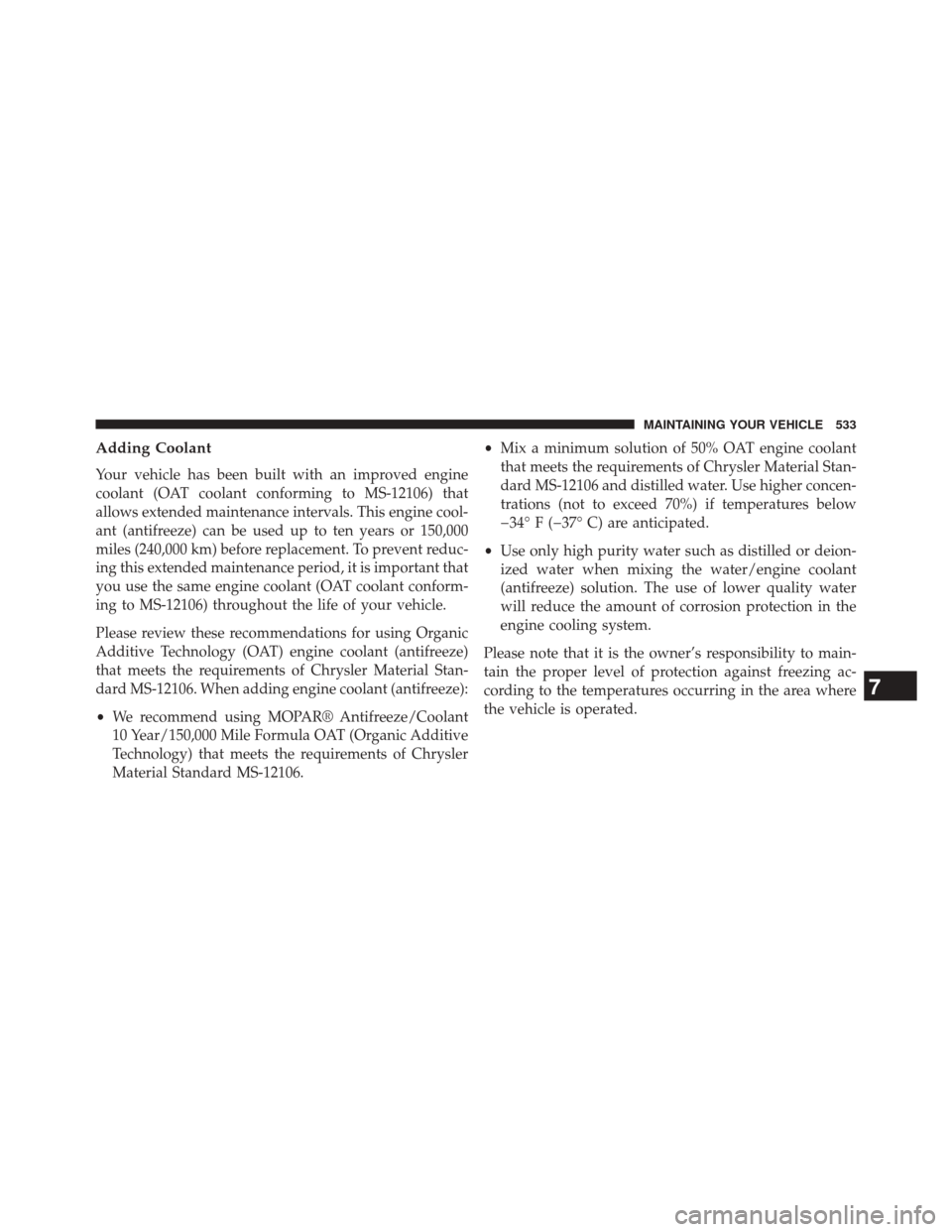
Adding Coolant
Your vehicle has been built with an improved engine
coolant (OAT coolant conforming to MS-12106) that
allows extended maintenance intervals. This engine cool-
ant (antifreeze) can be used up to ten years or 150,000
miles (240,000 km) before replacement. To prevent reduc-
ing this extended maintenance period, it is important that
you use the same engine coolant (OAT coolant conform-
ing to MS-12106) throughout the life of your vehicle.
Please review these recommendations for using Organic
Additive Technology (OAT) engine coolant (antifreeze)
that meets the requirements of Chrysler Material Stan-
dard MS-12106. When adding engine coolant (antifreeze):
•We recommend using MOPAR® Antifreeze/Coolant
10 Year/150,000 Mile Formula OAT (Organic Additive
Technology) that meets the requirements of Chrysler
Material Standard MS-12106. •
Mix a minimum solution of 50% OAT engine coolant
that meets the requirements of Chrysler Material Stan-
dard MS-12106 and distilled water. Use higher concen-
trations (not to exceed 70%) if temperatures below
�34° F (�37° C) are anticipated.
• Use only high purity water such as distilled or deion-
ized water when mixing the water/engine coolant
(antifreeze) solution. The use of lower quality water
will reduce the amount of corrosion protection in the
engine cooling system.
Please note that it is the owner’s responsibility to main-
tain the proper level of protection against freezing ac-
cording to the temperatures occurring in the area where
the vehicle is operated.
7
MAINTAINING YOUR VEHICLE 533
Page 537 of 615
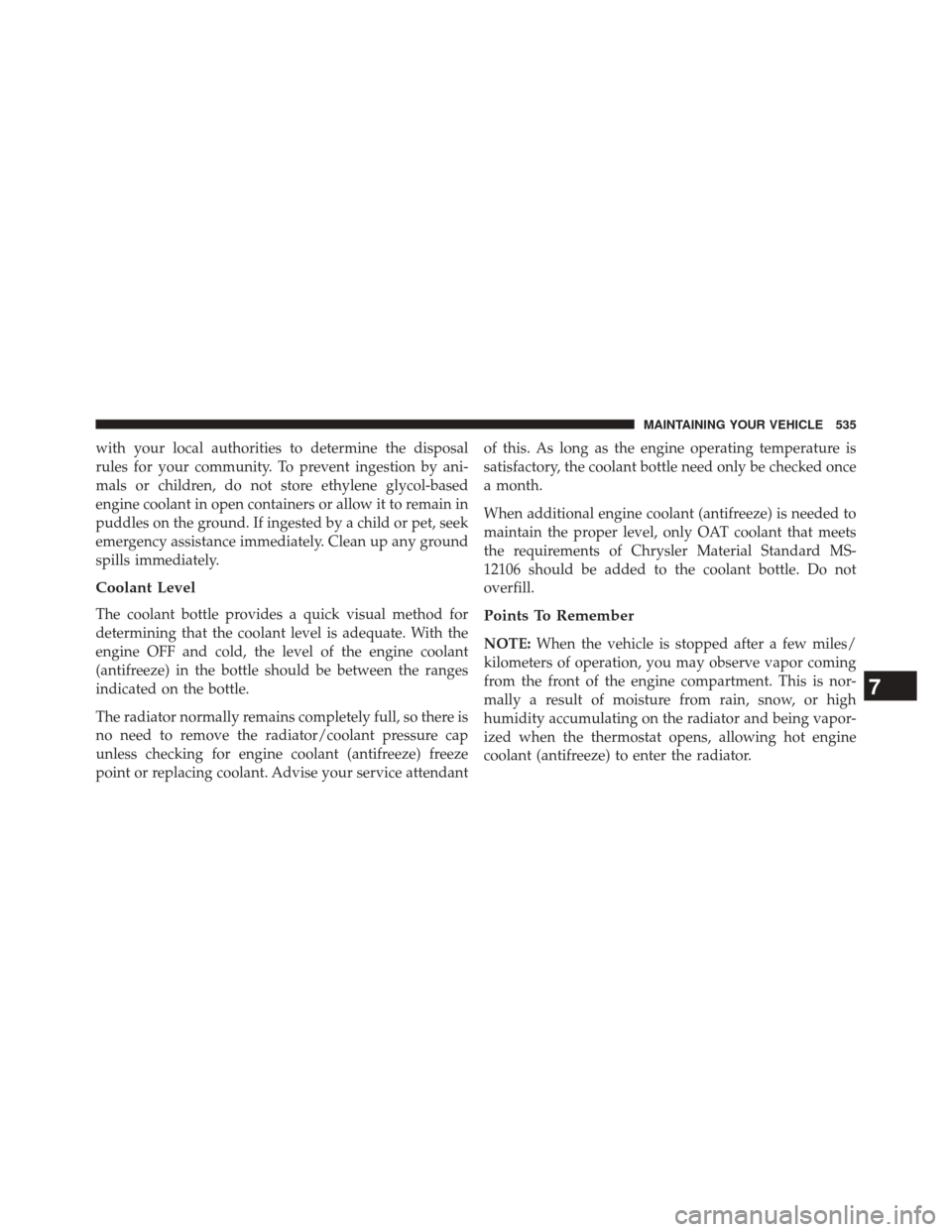
with your local authorities to determine the disposal
rules for your community. To prevent ingestion by ani-
mals or children, do not store ethylene glycol-based
engine coolant in open containers or allow it to remain in
puddles on the ground. If ingested by a child or pet, seek
emergency assistance immediately. Clean up any ground
spills immediately.
Coolant Level
The coolant bottle provides a quick visual method for
determining that the coolant level is adequate. With the
engine OFF and cold, the level of the engine coolant
(antifreeze) in the bottle should be between the ranges
indicated on the bottle.
The radiator normally remains completely full, so there is
no need to remove the radiator/coolant pressure cap
unless checking for engine coolant (antifreeze) freeze
point or replacing coolant. Advise your service attendantof this. As long as the engine operating temperature is
satisfactory, the coolant bottle need only be checked once
a month.
When additional engine coolant (antifreeze) is needed to
maintain the proper level, only OAT coolant that meets
the requirements of Chrysler Material Standard MS-
12106 should be added to the coolant bottle. Do not
overfill.Points To Remember
NOTE:
When the vehicle is stopped after a few miles/
kilometers of operation, you may observe vapor coming
from the front of the engine compartment. This is nor-
mally a result of moisture from rain, snow, or high
humidity accumulating on the radiator and being vapor-
ized when the thermostat opens, allowing hot engine
coolant (antifreeze) to enter the radiator.
7
MAINTAINING YOUR VEHICLE 535
Page 568 of 615
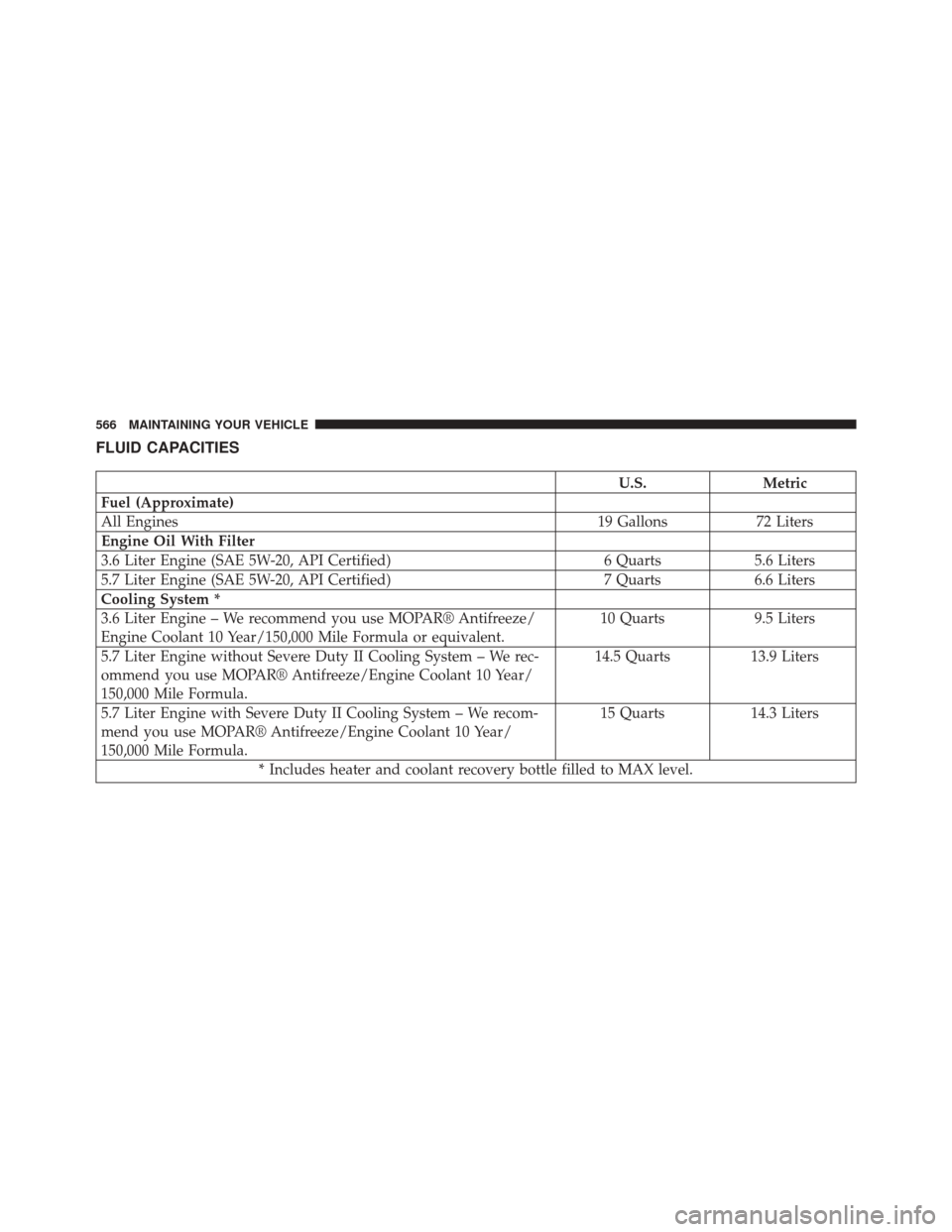
FLUID CAPACITIES
U.S.Metric
Fuel (Approximate)
All Engines 19 Gallons72 Liters
Engine Oil With Filter
3.6 Liter Engine (SAE 5W-20, API Certified) 6 Quarts5.6 Liters
5.7 Liter Engine (SAE 5W-20, API Certified) 7 Quarts6.6 Liters
Cooling System *
3.6 Liter Engine – We recommend you use MOPAR® Antifreeze/
Engine Coolant 10 Year/150,000 Mile Formula or equivalent. 10 Quarts
9.5 Liters
5.7 Liter Engine without Severe Duty II Cooling System – We rec-
ommend you use MOPAR® Antifreeze/Engine Coolant 10 Year/
150,000 Mile Formula. 14.5 Quarts
13.9 Liters
5.7 Liter Engine with Severe Duty II Cooling System – We recom-
mend you use MOPAR® Antifreeze/Engine Coolant 10 Year/
150,000 Mile Formula. 15 Quarts
14.3 Liters
* Includes heater and coolant recovery bottle filled to MAX level.
566 MAINTAINING YOUR VEHICLE
Page 575 of 615
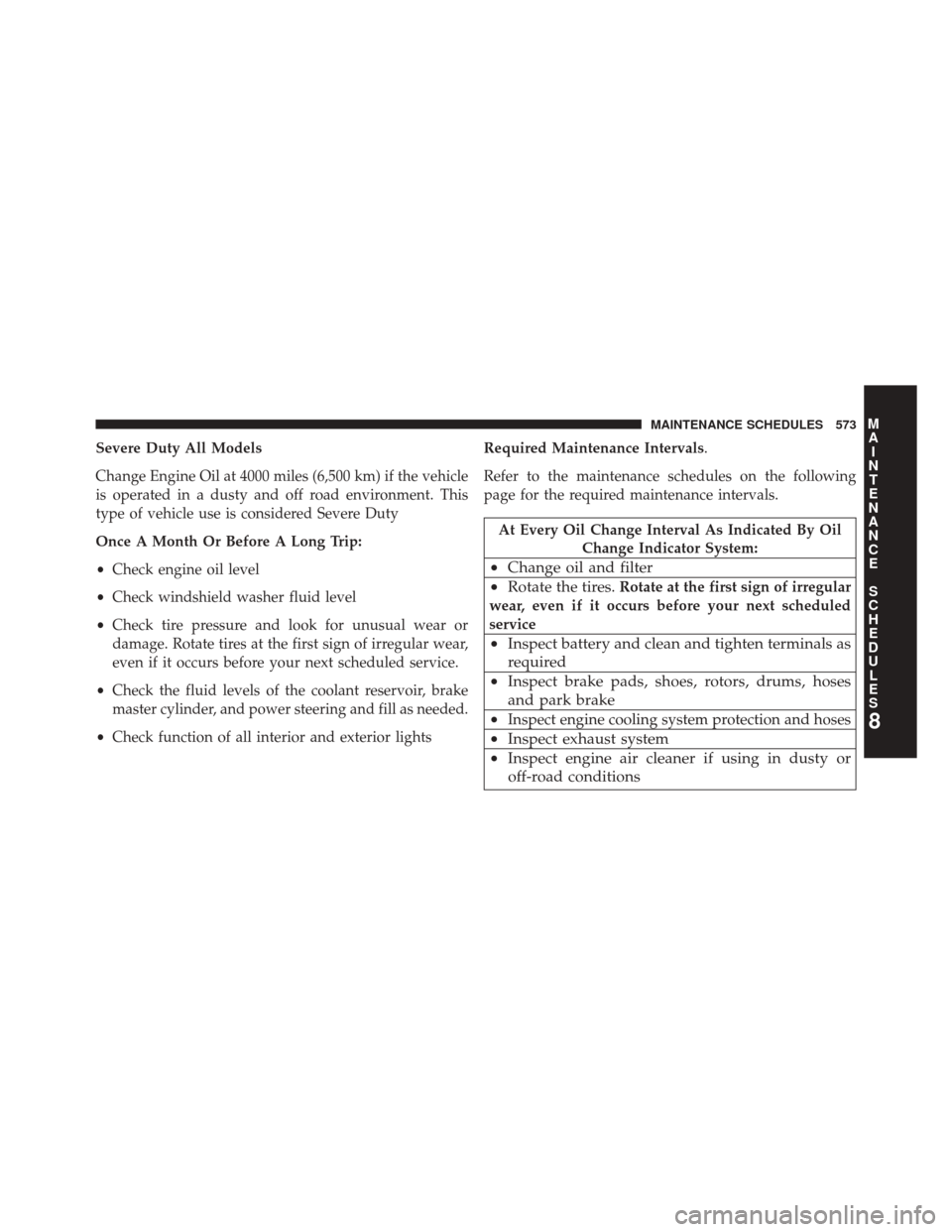
Severe Duty All Models
Change Engine Oil at 4000 miles (6,500 km) if the vehicle
is operated in a dusty and off road environment. This
type of vehicle use is considered Severe Duty
Once A Month Or Before A Long Trip:
•Check engine oil level
• Check windshield washer fluid level
• Check tire pressure and look for unusual wear or
damage. Rotate tires at the first sign of irregular wear,
even if it occurs before your next scheduled service.
• Check the fluid levels of the coolant reservoir, brake
master cylinder, and power steering and fill as needed.
• Check function of all interior and exterior lights Required Maintenance Intervals.
Refer to the maintenance schedules on the following
page for the required maintenance intervals.
At Every Oil Change Interval As Indicated By Oil
Change Indicator System:
•Change oil and filter
• Rotate the tires.
Rotate at the first sign of irregular
wear, even if it occurs before your next scheduled
service
• Inspect battery and clean and tighten terminals as
required
• Inspect brake pads, shoes, rotors, drums, hoses
and park brake
•
Inspect engine cooling system protection and hoses
• Inspect exhaust system
• Inspect engine air cleaner if using in dusty or
off-road conditions8
M
A I
N T
E
N
A
N
C E
S
C
H E
D
U L
E
SMAINTENANCE SCHEDULES 573
Page 595 of 615
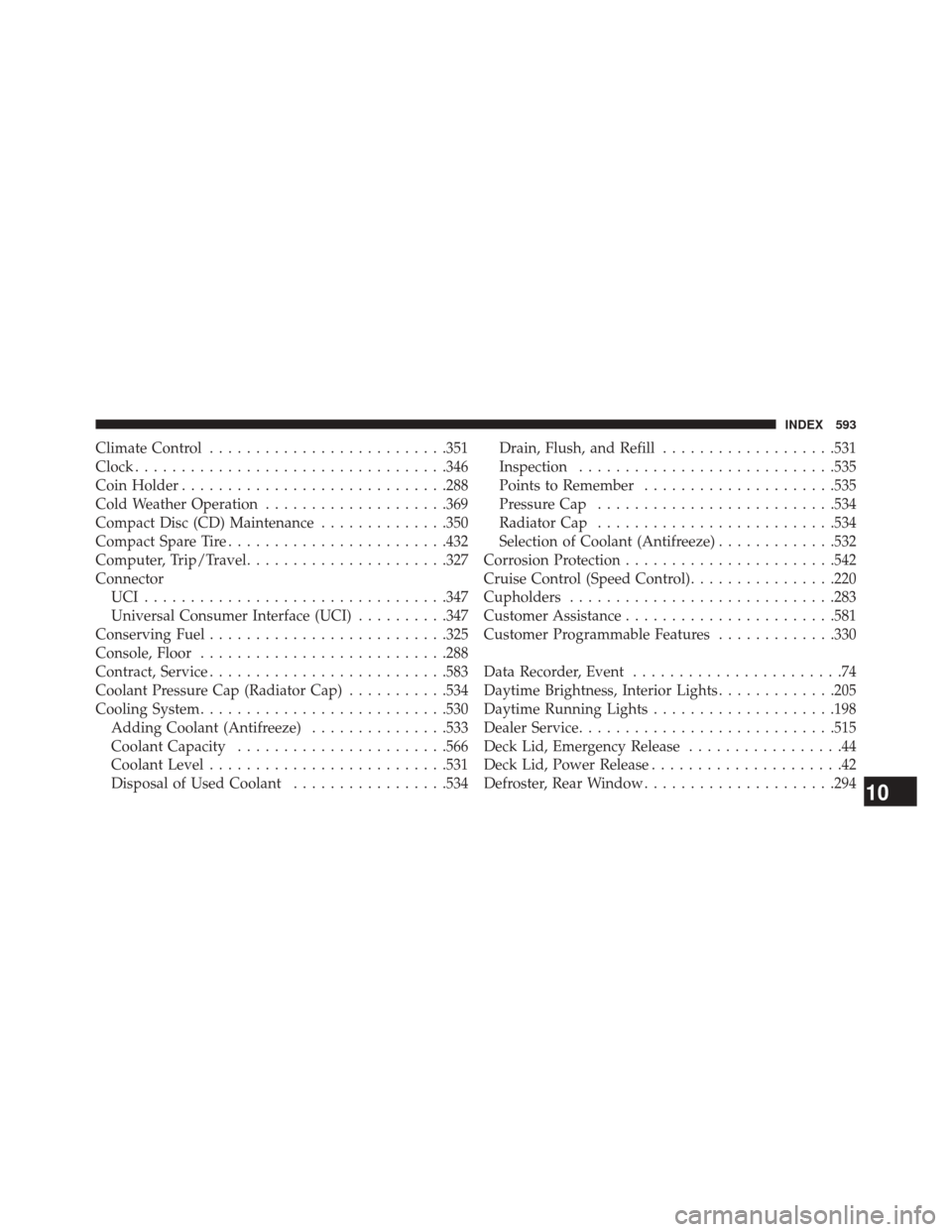
Climate Control......................... .351
Clock ................................. .346
Coin Holder ............................ .288
Cold Weather Operation ....................369
Compact Disc (CD) Maintenance ..............350
Compact Spare Tire ....................... .432
Computer, Trip/Travel ..................... .327
Connector UCI................................ .347
Universal Consumer Interface (UCI) ..........347
Conserving Fuel ......................... .325
Console, Floor .......................... .288
Contract, Service ......................... .583
Coolant Pressure Cap (Radiator Cap) ...........534
Cooling System .......................... .530
Adding Coolant (Antifreeze) ...............533
Coolant Capacity ...................... .566
Coolant Level ......................... .531
Disposal of Used Coolant .................534 Drain, Flush, and Refill
...................531
Inspection ........................... .535
Points to Remember .....................535
Pressure Cap ......................... .534
Radiator Cap ......................... .534
Selection of Coolant (Antifreeze) .............532
Corrosion Protection ...................... .542
Cruise Control (Speed Control) ................220
Cupholders ............................ .283
Customer Assistance ...................... .581
Customer Programmable Features .............330
Data Recorder, Event .......................74
Daytime Brightness, Interior Lights .............205
Daytime Running Lights ....................198
Dealer Service ........................... .515
Deck Lid, Emergency Release .................44
Deck Lid, Power Release .....................42
Defr
oster, Rear Window .....................294
10
INDEX 593
Page 597 of 615
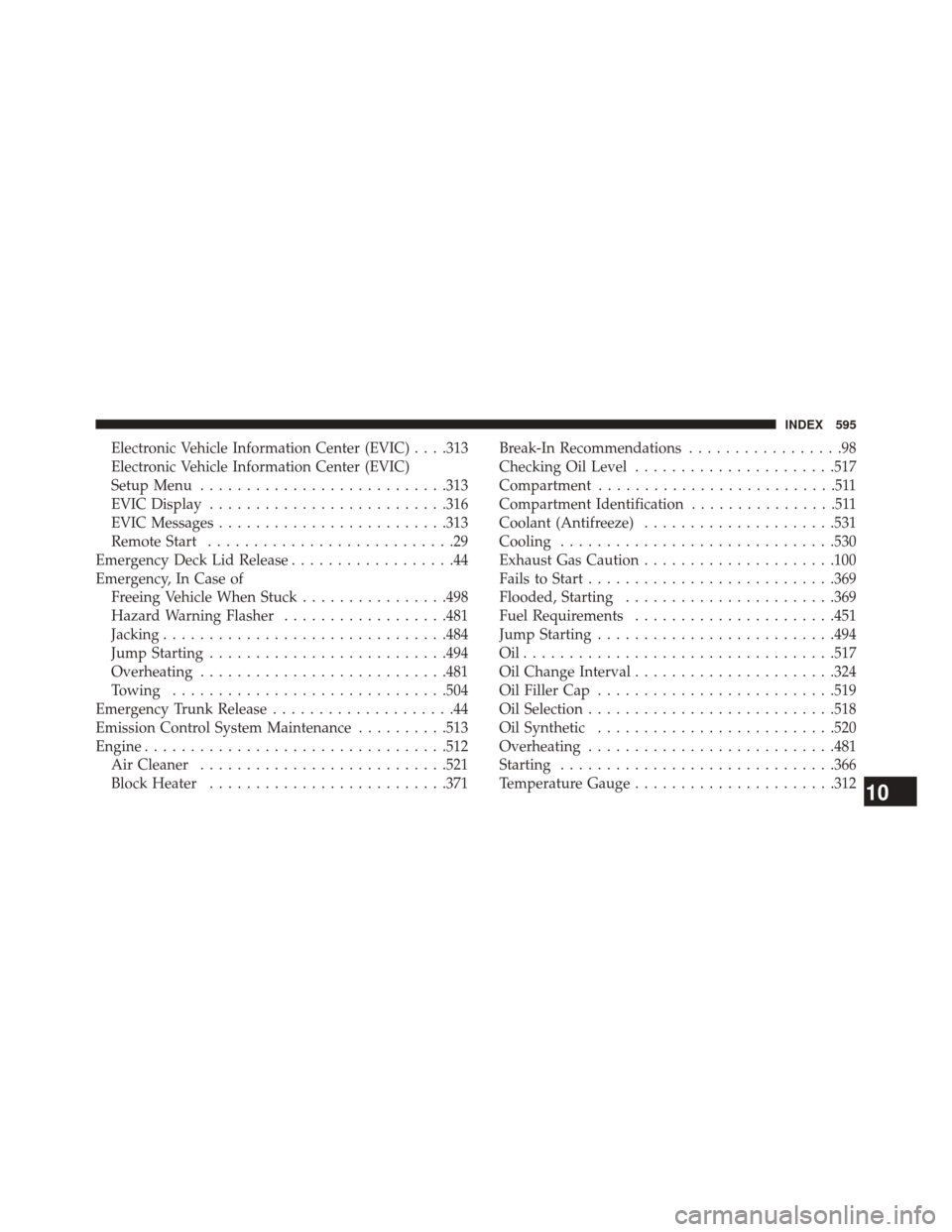
Electronic Vehicle Information Center (EVIC) . . . .313
Electronic Vehicle Information Center (EVIC)
Setup Menu.......................... .313
EVIC Display ......................... .316
EVIC Messages ........................ .313
Remote Start ...........................29
Emergency Deck Lid Release ..................44
Emergency, In Case of Freeing Vehicle When Stuck ................498
Hazard Warning Flasher ..................481
Jacking .............................. .484
Jump Starting ......................... .494
Overheating .......................... .481
Towing ............................. .504
Emergency Trunk Release ....................44
Emission Control System Maintenance ..........513
Engine ................................ .512
Air Cleaner .......................... .521
Block Heater ......................... .371Break-In Recommendations
.................98
Checking Oil Level ..................... .517
Compartment ..........................511
Compartment Identification ................511
Coolant (Antifreeze) .....................531
Cooling ............................. .530
Exhaust Gas Caution .....................100
Fails to Start .......................... .369
Flooded, Starting ...................... .369
Fuel Requirements ..................... .451
Jump Starting ......................... .494
Oil................................. .517
Oil Change Interval ..................... .324
Oil Filler Cap ......................... .519
Oil Selection .......................... .518
Oil Synthetic ......................... .520
Overheating .......................... .481
Starting ............................. .366
Temperature Gauge ..................... .312
10
INDEX 595